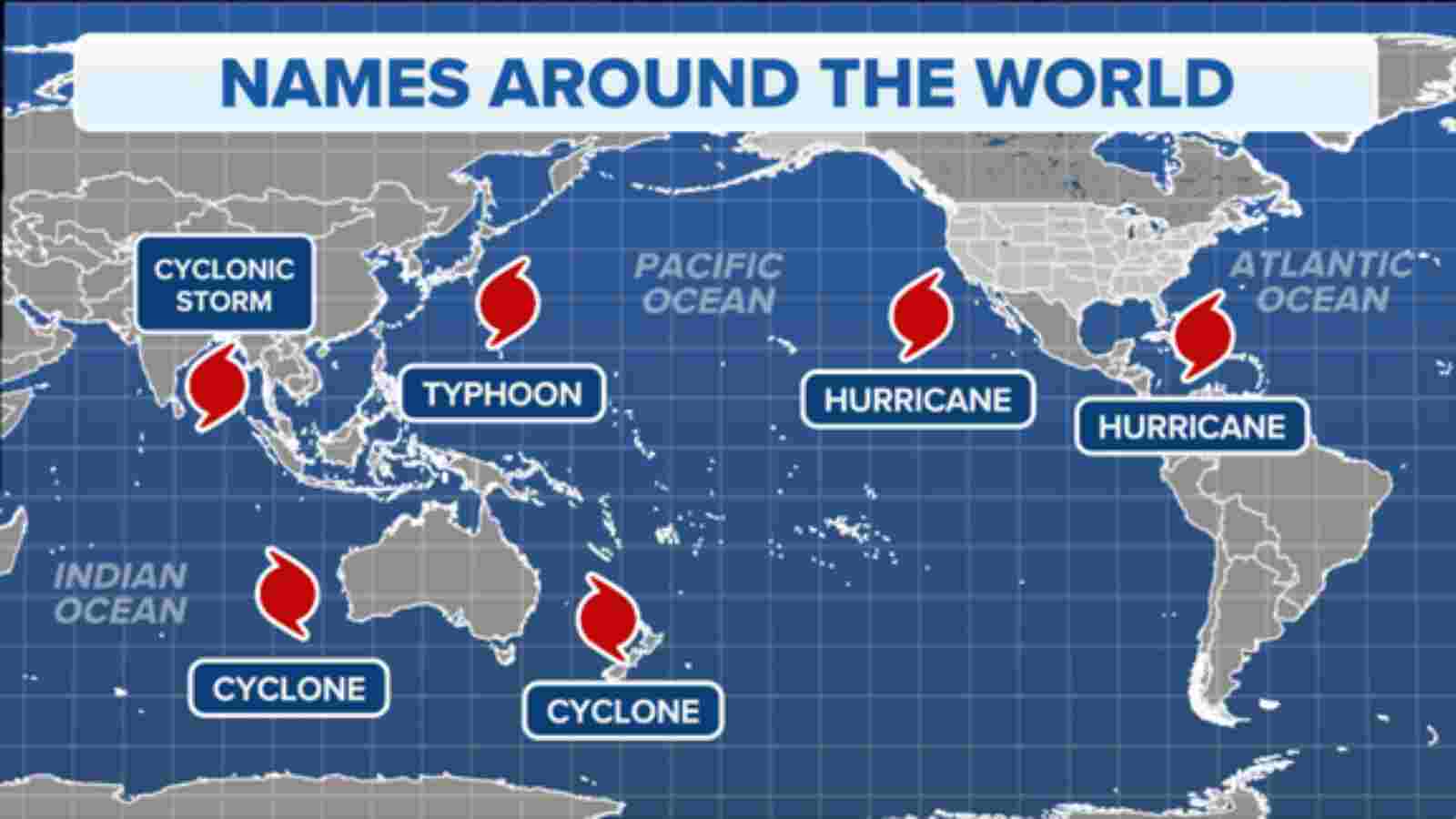Different Hurricane Names Used Globally: In the Atlantic and Eastern Pacific, tropical cyclones are known as hurricanes, although this is not the case in other ocean basins. In many parts of the world, hurricanes go by different names.
While residents of the East and Gulf coastlines of the United States are particularly familiar with hurricanes in the Atlantic, tropical storms in other ocean basins across the world are referred to by different names.
These five weather words apply to weather systems that are circulating in the tropics. It’s crucial to remember that these storms all share the same characteristics; only, depending on where they are on Earth, they go by different names.
Hurricane Hilary Forecast: Tropical Storm-Force Wind, Rain & Big Waves to be Observed in LA
Different Hurricane Names Used Globally
Here is the list of different Hurricane names used globally:

1. Hurricane: Atlantic, Central Pacific, and Eastern oceans
Describe a hurricane. All tropical cyclones with sustained winds of 74 mph or more that are located in the eastern and central Pacific Ocean (from the west coasts of Mexico, Central America, and the continental United States to the Hawaiian Islands) are referred to be hurricanes.
With the exception of those in the Central Pacific, which are watched over by the Central Pacific Hurricane Centre in Honolulu, Hawaii, these tropical storms are all tracked by the National Hurricane Centre in Miami.
Based on their maximum sustained winds, hurricanes in these basins are ranked using the Saffir-Simpson Hurricane Wind Scale.
Dora’s Unforgettable Odyssey: Tracing the Pacific Typhoons
2. Typhoon: Western Pacific Ocean
Tropical cyclones that are comparable to hurricanes are known as typhoons in the Western Pacific.
The China Meteorological Administration, the Hong Kong Observatory, the Japan Meteorological Agency, or PAGASA in the Philippines can all keep an eye on them, depending on where they are in the basin.
The Joint Typhoon Warning Centre of the United States, with its main office in Pearl Harbour, Hawaii, also keeps an eye on the Western Pacific Basin in order to help safeguard American military bases that are shared with other nations as well as any military ships or aircraft that may be in danger.
A super typhoon is defined by the JTWC as a typhoon with maximum sustained winds of 150 mph or above. On the Saffir-Simpson storm Wind Scale, that equates to a high-end Category 4 or Category 5 storm.
3. Cyclone: Northern Indian Ocean
Once their winds exceed 39 mph, which is equal to a tropical storm in the Atlantic, tropical cyclones in the Northern Indian Ocean, which consists of the Arabian Sea and the Bay of Bengal, are referred to as cyclonic storms. A Category 1 hurricane on the Saffir-Simpson Hurricane Wind Scale, they are classified as severe cyclonic storms at 55 mph and extremely severe cyclonic storms at 74 mph. The storm is then referred to as a super cyclonic storm at 138 mph and an extremely severe cyclonic storm at 104 mph.
The India Meteorological Department and the JTWC keep an eye on every cyclone in the northern Indian Ocean in case it affects any U.S. interests there.
4. Tropical Cyclones: Southern Indian Ocean
The nomenclature of the Southern Indian Ocean, which simply refers to tropical storms as “tropical cyclones,” is fairly simple to recall. They can be classified as intense tropical cyclones (104 mph) and extremely intense tropical cyclones (133 mph) when they intensify.
This maritime basin, which runs from Africa to 90 degrees east longitude, is observed by Météo-France’s La Réunion tropical cyclone centre. The JTWC is also responsible for informing any U.S. interests during a storm.
Because weather systems in the Southern Hemisphere rotate in the opposite direction from those in the Northern Hemisphere, tropical cyclones in the Southern Indian Ocean do so.
5. Cyclone: Southwestern Pacific Ocean
The Southwestern Pacific Ocean is the most fundamental of all, where tropical cyclones are simply known to as cyclones.
The Fiji Meteorological Service, New Zealand MetService, Indonesia’s Badan Meteorologi, Klimatologi, dan Geofisika, Papua New Guinea’s National Weather Service, and the Australian Bureau of Meteorology all keep an eye on this basin and climate east of 90 degrees east longitude. The JTWC also covers any U.S. interests in those areas.
The Australian BOM classifies cyclones in its jurisdiction using a unique 1-to-5 scale. The Saffir-Simpson Hurricane Wind Scale in the United States and this Australian scale of tropical cyclone severity employ distinct wind speeds to determine ratings.
Since this is also the Southern Hemisphere, cyclones here rotate in the opposite direction of those in the Northern Hemisphere, which is anticlockwise.




